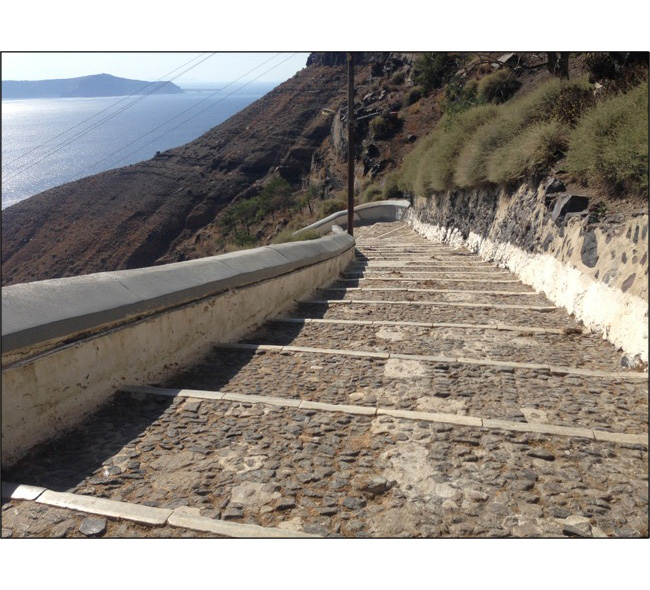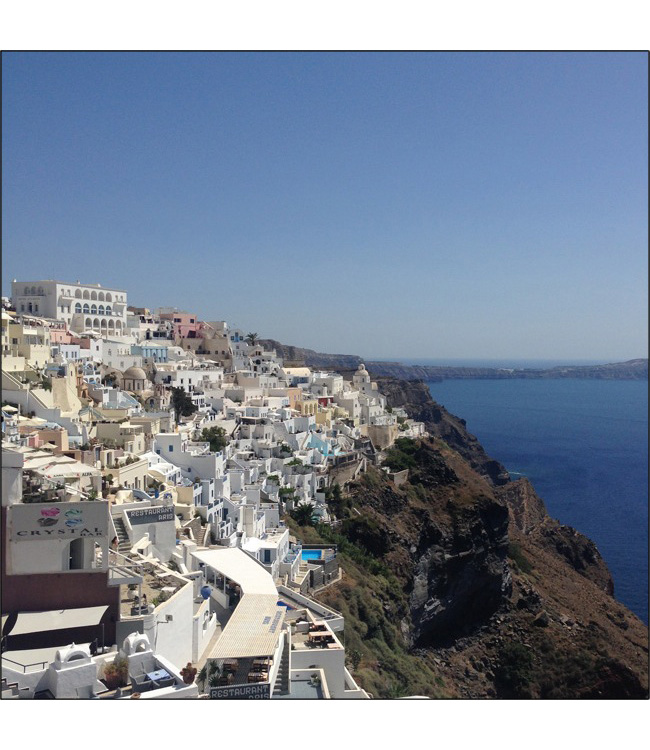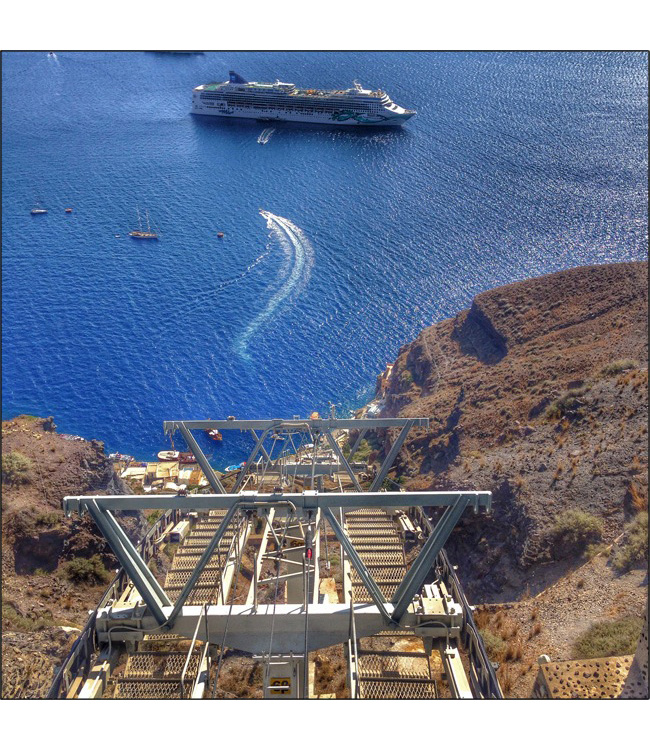
 Ding-dong! Allo this is your keptin specking. I would like to inform you of our progress to Santorini. As far as we can tell it is straight ahead, which is where it has always been. Ding-dong! Allo this is your keptin specking. I would like to inform you of our progress to Santorini. As far as we can tell it is straight ahead, which is where it has always been.
“The captain’s lost it,” Daughter said.
We pulled up at 10:30, and beheld the options for getting up to the city of Fira. There was the cable car, which combines my love of high spaces in enclosed spaces with my love of enclosed spaces going up to high places. The lady at the front desk had mentioned something about “donkey rides,” which sounded picturesque; you imagined a fellow at the bottom of the cliff with a burro, offering the beast for five euros. Or you could walk up, which she did not recommend, on account of the distance and the innumerable steps involved.
When we got ashore the line for the cable cars was very long, a consequence of 2,000 crashing a port at once. So, donkeys! We went to the donkey line and was struck by the immensity of the stink, the innumerable road apples both squashed and intact, the reek of the hey and the stench of the beasts themselves. They seemed balky and uninterested in performing their duty, which made you doubt instantly the veracity of all the posters and T-shirts and gewgaws that showed happy, willing donkeys.
“Let’s walk,” I said.
Here is the route.

Five hundred and sixty-seven steps. They're long steps, too:

We had two bottles of water. It became apparently quite quickly we would have to ration our supplies for the climb. It was, I need not remind you, July, in Greece. You could fry an egg on an ice cube.
A few switchbacks up we found a nice niche that would have been an excellent spot for a small bar; seems it had served that function once, as it had benches and something like a table. We chatted with some Brits who were also dying but cheerful about it. They’d met some donkeys coming down, and the lass astride one of them leaned over and said “Worst Day of my Life.”
We continued on, up the shite-strewn path. By “567 steps” they mean a step, then a yard of irregular, ankle-snapping stone, followed by another step, followed by a yard of irregular, ankle-snapping stone smeared with ordure, and so on. Another herd of donkeys, this one thicker than the last, and not particularly concerned with our presence. Suddenly you realized you had two options: you would be crushed against the wall by donkeys, or pushed over the side by donkeys. Neither seemed appealing, just like the growing belief you would either suffer failure of the heart or the kidneys.
Like this.

Donkey Crushing from James Lileks on Vimeo.

The donkeys got out of the way if you shoved them, and their muzzles kept them from biting, so there was that. After a few more herds you became Donkey Avoidance Experts, and learned to pause behind a big stone set in the wall or a light pole. But still they pressed close; one fellow riding high did not mean to put his knee into my solar plexus, yet it happened.
There was also a Japanese princess:

In high heels. In HIGH. HEELS. On and on we went, running out of water just before the final push. At one bend there was a teenager in tears, consoled by her mother, urging her on. When we got to the top and passed another dozen stinking donkeys and two more teen girls in tears after the ordeal, there was a sense of exhilaration and accomplishment marred only slightly by the knowledge that the rest of the G-D TOWN WAS HIGHER STILL, and the streets loomed up at 45 degree angles. There were restaurants and places to sit, but you knew you’d be paying that first-place premium, so we pressed on until we could stand no more and hello, it’s a Haagen-Daaz place. So. Reward.
There was nothing else to do but wander and look at things, then marvel at the bay, then admire the houses, then the bay, and so on, from many views and vantage points. It’s so beautiful you cannot imagine why you wouldn’t want to live here, except for the part about walking up the bleeping side of a cliff when you wanted to go down to the water.

After a while we discovered the flat part of the island that goes right down to the sea. WHY THE HELL DIDN’T WE DOCK HERE? you wonder. Was that just to extract the donkey tax from tourists? Perhaps the first settlers never looked that way. It was bad luck to look west! The invaders will surely only come from this side and see the cliffs and leave, muttering curses and shaking their futile fists. Yes, that’s the plan.
After the OOC, or Obligatory Old Church - this one with a hairy-lipped matron loudly shushing every who came in - we walked higher and higher, past a conference center where I swear a fellow I follow on Twitter was tweeting from last week, and then back down to the cable cars. Daughter was urging me to Conquer My Fears and have an adventure, and you know? She had a point. Just because I didn’t want to shoot out over this vista . . .

. . . and ride down the side of the cliff didn’t mean that I shouldn’t. What are these trips about, if not pushing yourself, discovering new things, finding out that things you didn’t like were just marvelous, exhilarating experiences you had not yet learned to embrace? Exult in your fears! Ride down the cliff, my hearties, for tonight we dine at Cagney’s! (That’s the steakhouse on board. We had reservations.
“See you down at the dock,” I said. “Bet I beat you.”
“Don’t run,” Daughter said. “Please don’t. You’ll hurt yourself.”
I headed off through the narrow streets of the town, heading down and down until my nose and the Haagen-Daaz sign said I was close to the trail of hamstring hell, and got behind a family of four who’d had their entire fill of Santorini yes sir no doubt about it; something about being with two loud small boys had made Dad snap, and when he encountered the donkeys waiting in their Donkey Area, munching on hay and enjoying the shade, he just pushed them out of the way. The entire day had turned him into a Donkey Shover. His son gagged on the aromas and made conspicuous sounds of imminent heaving; he pushed, and shoved, and would probably have cold-cocked one right in the muzzle if it hadn’t moved of its own accord.
I started down the path, and realized that if I ran I could make good time. I got a rhythm going, bobbing on my feet, trying to avoid the slippery segments. Here I am walking down the most spectacular path I’ve ever traversed, and my eyes are right on the pavement looking for crap and hay. Uh-oh: incoming. Another herd clopping up the path, all the donkeys wearing the same expression: hell with you. Hell with you and you. Like I care. God. I flattened myself against the wall and kept going. At the end there was but one donkey in the departure zone, and astride it was a chubby five-year-old holding tight to the reins and wearing an expression of great apprehension.
“GOOD BYE DARLING,” shouted Mommy from the platform. “HAVE A GOOD TIME. IT’S PERFECTLY SAFE.”
I suppose it was, but really, I felt for the kid.
I beat the family down, as it happens, but only because they went shopping. Most times when we return to ship we take the stairs up 7 floors to our room. This time? The elevator looked damned good.
|